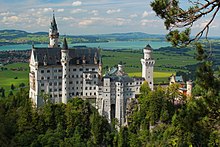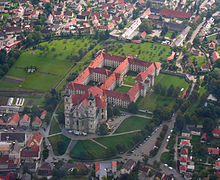Bavarian Swabia is in the western part of Bavaria and its borders coincide with the administrative region (Regierungsbezirk), of which there are seven.
Bavarian Swabia is a part of the much larger Schwaben cultural region which extends across borders into the eastern part of the neighbouring Land of Baden-Württemberg, the northern fringe of Switzerland, the Vorarlberg of Austria and Liechtenstein.

Cities
edit- 1 Augsburg - The region's largest city, filled with top-notch amenities, great museum, and good nightlife
- 2 Füssen - Town at the end of the Romantic Road in the Bavarian Alps, home of the famous Neuschwanstein castle
- 3 Kaufbeuren
- 4 Kempten - Biggest city in the Allgau region, offering several big city amenities near beautiful landscapes
- 5 Lindau — the Bavarian port "island" city on Lake Constance (Bodensee)
- 6 Memmingen - Quaint town with typically Bavarian architecture. Also known for its low-cost airport.
- 7 Nördlingen
- 8 Neu-Ulm - Essentially the Bavarian extension of Ulm.
- 9 Donauwörth
Other destinations
editUnderstand
editGet in
editBy plane
editMemmingen Airport (FMM IATA), is a small airport about 4 km from the centre of Memmingen. It is mostly used by no-frills carriers who market it deceptively as being closer to Munich than it actually is.
Munich and Stuttgart airports are close to the region, and most cities and towns can be easily reached by car. For public transportation, you will most definitely need to transfer once or twice.
By train
editMost areas have connections to Munich, though frequencies might decrease the further away you go.
Augsburg and Neu-Ulm (just across the border from Ulm) are both well connected by train with frequent departures for Munich, Stuttgart and Nürnberg as well as some high speed trains to places as far away as Paris or Vienna. As part of the greater "Stuttgart 21" project, the line connecting Stuttgart and Ulm is being upgraded, but there is no completion date in sight.
By car
editYou can take the car to Swabia, but why should you? Gasoline is expensive and (almost) everything is well reachable by public transit. Should you nonetheless decide to take the car the A7 and A8 connect to Neu-Ulm and Augsburg respectively.
Get around
edit
By car
editBy train
editBy bus
editMost of the cities like Augsburg and Kempten have decent bus connections between them and with nearby suburbs. However, a lot of smaller settlmeents tend to only have a few buses per day, and on weekends those may be non-existent.
See
edit

- Romantic, well preserved medieval old town of Nördlingen with perfectly round town fortification, narrow lanes, and tile-roofed small houses
- Old town of Augsburg with the splendid Renaissance townhall, demonstrating the pride and wealth of the erstwhile Imperial Free Town, and the Fugger Palace of the most powerful banking family in 16th-century Europe
- High-medieval Harburg Castle (12 km northwest of Donauwörth)
- 19th-century romantic-historistic castles of Neuschwanstein and Hohenschwangau near Füssen
- huge Benedictine abbey and late-Baroque basilica of Ottobeuren (11 km southeast of Memmingen), dubbed the "Swabian Escorial"
- Baroque pilgrimage churches Maria Steinbach (15 km south of Memmingen) and Violau (22 km south of Günzburg)
Itinaries
edit- The Romantic Road crosses Bavarian Swabia from north to south and links most of its popular historic and cultural sights: Dinkelsbühl – Nördlingen – Donauwörth – Augsburg – Schongau – Füssen
- The Iller cycling trail along the river Iller that forms the border between Bavarian Swabia and Baden-Württemberg, continued by the Danube Cycleway: Oberstdorf – Kempten – Memmingen – Neu-Ulm – Günzburg – Donauwörth (– Ingolstadt ...)
Do
edit- Hiking and climbing in the Allgäu Alps
Eat
editDrink
editStay safe
editAs with the rest of Bavaria, the Bavarian Swabia region is very safe. Besides a few specific neighbourhoods in Augsburg, certain train stations, and the occasional drunkards on weekends, you can meander around the region without too much to worry about.
The region does get a decent amount of snow during the winter season, more so in the mountains. Therefore, it is wise to watch out for slippery roads and streets, and make sure you are dressed properly.

